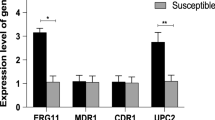Abstract
Most cases of fungal bloodstream infections (BIs) are attributed to Candida albicans; however, non-Candida albicans Candida species have recently been identified as common pathogens. Although hemolytic factor is known to be putative virulence factor contributing to pathogenicity in Candida species, its production is poorly evaluated. The present study was undertaken to analyze the production of hemolytic factor by C. albicans (10), C. tropicalis (13), and C. parapsilosis (8) isolates associated with BIs. Data of hemolysis zones on plate assay revealed that the majority of C. albicans isolates produced mild hemolytic activity whereas the majority of C. tropicalis produced strong activity. None of the tested C. parapsilosis isolates exhibited hemolysis on plate assay. We also evaluated the hemolytic activity in the cell-free broth. There were no significant differences (P > 0.05) in the secreted hemolytic activity among intra-species isolates. Different levels of secreted hemolytic factor were observed for Candida species, where C. tropicalis exhibited the highest production of hemolytic factor (P < 0.05) followed by C. albicans and C. parapsilosis. Inhibition of hemolysis (up to 89.12 %) from culture supernatant, following incubation with the lectin Concanavalin A (Con A), was observed for all three Candida species. This finding suggests that the secreted hemolytic factor of C. tropicalis and C. parapsilosis may be a mannoprotein, similar to that described for C. albicans.


Similar content being viewed by others
References
Holley A, Dulhunty J, Blot S et al (2009) Temporal trends, risk factors and outcomes in albicans and non-albicans candidaemia: an international epidemiological study in four multidisciplinary intensive care units. Int Antimicrob Agents 33:554e1–554e7
The Brazilian SCOPE Study Group, Marra AR, Camargo LFA, Pignatari ACC (2011) Nosocomial bloodstream infections in Brazilian hospitals: analysis of 2,563 cases from a prospective nationwide surveillance study. J Clin Microbiol 49:1866–1871
Aydin F, Bayramoglu G, Guler NC, Kakikkaya N, Tosun I (2011) Bloodstream yeast infections in a university hospital in Northeast Turkey: a 4-year survey. Med Mycol 49:316–319
Gomez J, Garcia-Vasquez E, Espinosa C et al (2009) Nosocomial candidemia at a general hospital: the change of epidemiological and clinical characteristics—a comparative study of 2 cohorts (1993–1998 vs. 2002–2005). Rev Iberoam Micol 26:184–188
Lim CS-Y, Rosli R, Seoe HF, Chong PP (2012) Candida and invasive candidiasis: back to basics. Eur J Clin Microbiol Infect Dis 31:21–31
Silva S, Negri M, Henriques M, Oliveira R, Williams DW, Azeredo J (2012) Candida glabrata, Candida parapsilosis and Candida tropicalis: biology, epidemiology, pathogenicity and antifungal resistance. FEMS Microbiol Rev 36:288–305
Trofa D, Gácser A, Nosanchuk JD (2008) Candida parapsilosis: an emerging fungal pathogen. Clin Microbiol Rev 21:606–625
Odds FC (1988) Candida and candidosis: a review and bibliography. Bailliere Tindall
Manns JM, Mosser DM, Buckley HR (1994) Production of a hemolytic factor by Candida albicans. Infect Immun 62:5154–5156
Watanabe T, Tanaka H, Nakao N, Mikami T, Matsumoto T (1997) Hemoglobin is utilized by Candida albicans in the hyphal form but not yeast form. Biochem Biophys Res Commun 232:350–353
Pendrak ML, Yan SS, Roberts DD (2004) Sensing the host environment: recognition of haemoglobin by the pathogenic yeast Candida albicans. Arch Biochem Bioph 426:148–156
Watanabe T, Takano M, Murakami M et al (1999) Characterization of a hemolytic factor from Candida albicans. Microbiology 145:689–694
Luo G, Samaranayake LP, Yau JY (2001) Candida species exhibit differential in vitro hemolytic activities. J Clin Microbiol 39:2971–2974
Favero D, França EJG, Furlaneto-Maia L, Quesada RMB, Furlaneto MC (2011) Production of haemolytic factor by clinical isolates of Candida tropicalis. Mycoses 54:e816–e820
França EJG, Furlaneto-Maia L, Quesada RMB, Favero D, Oliveira MT, Furlaneto MC (2010) Haemolytic and proteinase activities in clinical isolates of Candida parapsilosis and Candida tropicalis with reference to the isolation anatomic site. Mycoses 54:e44–e51
Furlaneto MC, Rota JF, Quesada RMB et al (2011) Species distribution and in vitro fluconazole susceptibility of clinical Candida isolates in a Brazilian tertiary-care hospital over a 3-year period. Rev Soc Bras Med Trop 44:595–599
Bullen J (1981) The significance of iron in infection. Rev Infect Dis 3:1127–1138
Bonassoli LA, Bertoli M, Svidzinski TIE (2005) High frequency of Candida parapsilosis on the hands of healthy hosts. J HospInfect 59:159–162
Trevino-Rangel R, Gonzalez JG, Gonzalez GM (2013) Aspartyl proteinase, phospholipase, esterase and hemolysin activities of clinical isolates of the Candida parapsilosis species complex. Med Mycol 51:331–335
Yigit N, Aktas E (2009) Comparison of the efficacy of different blood medium in determining the hemolytic activity of Candida species. J Mycol Med 19:110–115
Yan S, Rodrigues RG, Cahn-Hidalgo D, Walsh T, Roberts DD (1998) Hemoglobin induces binding of several extracellular matrix proteins to Candida albicans. J Biol Chem 273:5638–5644
Acknowledgments
This study was supported by Conselho Nacional de Desenvolvimento Científico e Tecnológico (CNPq)–Brazil, Fundação Araucária/SETI/Governo do Paraná–Brazil, and PROPPG/UEL-Brazil. E.J.G.F., D.F., and H.P.G. were fellowship holders of Coordenação de Aperfeiçoamento de Pessoal de Nível Superior (CAPES) - Brazil.
Conflict of interest
The authors report no conflicts of interest.
Author information
Authors and Affiliations
Corresponding author
Rights and permissions
About this article
Cite this article
Favero, D., Furlaneto-Maia, L., França, E.J.G. et al. Hemolytic Factor Production by Clinical Isolates of Candida Species. Curr Microbiol 68, 161–166 (2014). https://doi.org/10.1007/s00284-013-0459-6
Received:
Accepted:
Published:
Issue Date:
DOI: https://doi.org/10.1007/s00284-013-0459-6




